Rothy's Inc. (a company incorporated under the laws of Delaware, USA) v Giesswein Walkwaren AG (a company incorporated under the laws of the Republic of Austria)
| Jurisdiction | England & Wales |
| Judge | David Stone |
| Judgment Date | 16 December 2020 |
| Neutral Citation | [2020] EWHC 3391 (IPEC) |
| Date | 16 December 2020 |
| Docket Number | Case No: IP-2019-000084 |
| Court | Intellectual Property Enterprise Court |
[2020] EWHC 3391 (IPEC)
IN THE HIGH COURT OF JUSTICE
BUSINESS AND PROPERTY COURTS OF
ENGLAND AND WALES
INTELLECTUAL PROPERTY (Ch)
INTELLECTUAL PROPERTY ENTERPRISE COURT
COMMUNITY DESIGN COURT
The Rolls Building
7 Rolls Buildings
Fetter Lane
London EC4A 1NL
Mr David Stone
(Sitting as a Deputy High Court Judge)
Case No: IP-2019-000084
Ms Lindsay Lane QC (instructed by BIRD & BIRD LLP) for the Claimant
Mr Thomas Jones (instructed by STOBBS IP) for the Defendant
Hearing dates: 16 and 17 November 2020 remotely via Skype for Business
Approved Judgment
David Stone (sitting as a Deputy High Court Judge):
Women's shoes known as “ballet flats” or “ballerinas” have been popular since at least the 1950s. They come in many variations – with differently shaped toes, different heel heights, and many types of materials. On 24 November 2017, the Claimant, Rothy's Inc, a California-based company, launched its Pointed Loafer shoe. The Pointed Loafer is a type of ballerina shoe with, as the name suggests, a pointed toe and a protruding tongue that gives the appearance of a loafer. The Pointed Loafer is shown here:
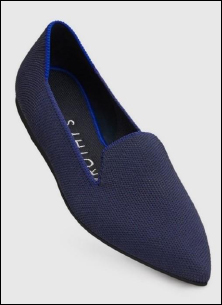
The Pointed Loafer had been preceded to market by two of the Claimant's other shoes, known as The Flat and The Point. It was common ground between the parties that The Flat and The Point were the first ballerina shoes to be made of knitted yarn made from recycled plastic. Gym shoes had previously been made from heavy knitted yarn, including yarn made from recycled plastic, but not ballerina shoes.
In or about April 2019, the Defendant, Austrian shoe company Giesswein Walkwaren AG, began marketing through its website a range of ballerina shoes the upper parts of which were in a knitted meshwork fabric made from recycled plastic. Relevantly, those shoes included the Pointy Flat, shown here:

On 23 July 2019, the Claimant issued these proceedings, alleging that the Pointy Flat infringed two of the Claimant's EU-wide design rights:
(a) registered Community design 4500932-0002 filed on 9 November 2017 and registered later that day (the RCD). The RCD lists “shoes” as the product to which the design is to be applied, and claims priority from United States design patent 29/603,576 filed on 10 May 2017; and
(b) unregistered Community design right in the design of the Pointed Loafer as first disclosed in the European Union on 24 November 2017 (the UCD).
The RCD includes seven views (the maximum currently allowed by the registering authority, the European Intellectual Property Office (the EUIPO)):
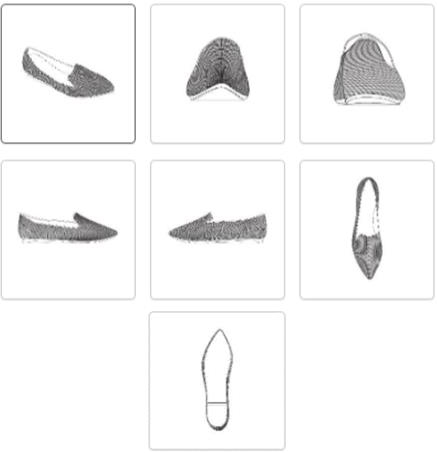
The UCD arises from the disclosure of images of the Pointed Loafer on the Claimant's website, in emails sent to people based in the European Union and on various social media sites including Facebook and Instagram. These images show the Pointed Loafer shoe in various colourways. Some of those images are excerpted below:
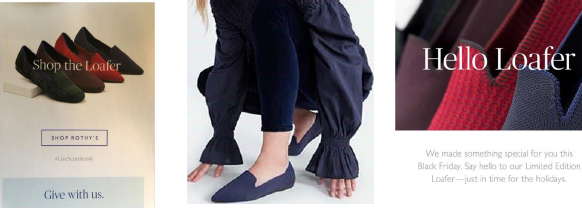
The Defendant has counterclaimed for invalidity of the RCD and the UCD on the basis of two prior designs (together, the Prior Designs):
(a) the Allegra K shoe shown here:
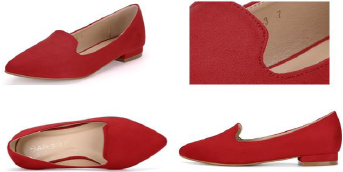
(b) and the Bonnibel shoe shown here:
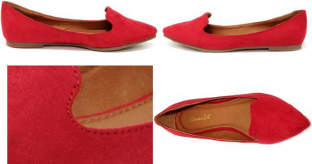
I was provided with samples of the Pointed Loafer, the Pointy Flat and the Allegra K. The Bonnibel was in evidence through photographs only.
At the remote trial of this matter on 16 and 17 November 2020, Ms Lindsay Lane QC appeared for the Claimant and Mr Thomas Jones appeared for the Defendant. The Court sat as a Community Design Court, that is, as one of the national courts designated to hear EU design matters under Article 80 of Council Regulation (EC) 6/2002 of 12 December 2001 on Community designs (the Regulation). As things currently stand, this Court will be unable to sit as a Community Design Court after 11pm UK time on 31 December 2020, given the current end date to the transition period following the UK's departure from the European Union. I was therefore urged by the Claimant to hand down this judgment in sufficient time to enable a form of order hearing to be held prior to 31 December 2020. This judgment has therefore been prepared at speed in an attempt to accommodate that request.
List of Issues
As is usual in the IPEC, the list of issues for determination at trial was annexed to the order of HHJ Hacon of 4 March 2020 (I have substituted the defined terms I have already set out above):
“ Design Corpus
1. The state of the design corpus as at 10 May 2017.
Registered design
2. Whether the RCD produces on the informed user a different overall impression from that produced by any of the designs of the Allegra K or Bonnibel.
3. Whether the Pointy Flat produces on the informed user the same overall impression as is produced by the RCD.
Unregistered Design
4. Whether the UCD was made available to the public within the Community by reason of the acts identified at paragraph 6 of the Particulars of Claim [that is, the publication on the Claimant's website, the emails, and the social media posts].
5. Whether any subsisting rights in the UCD are the property of the Claimant.
6. Whether the UCD produces on the informed user a different overall impression from that produced by any of the designs of the Allegra K or Bonnibel.
7. Whether the Pointy Flat is an article which has been made by copying the UCD.
8. Whether the Pointy Flat produces on the informed user the same overall impression as is produced by the UCD.”
The Defendant conceded issues 4 and 5.
I add for completeness that validity of the RCD was to be assessed as at its priority date (10 May 2017), and validity of the UCD as at the date of the launch of the Pointed Loafer (24 November 2017). The parties agreed between them that nothing happened between those two dates that made a difference, and so I say no more about it, but rather adopt the expression Relevant Date.
The Witnesses
By permission of HHJ Hacon, the Claimant adduced evidence from two witnesses of fact, and a single expert witness. All three were cross-examined remotely.
William Martin
William Roth Martin is Co-Founder and Chief Creative Offer of the Claimant. He gave evidence as to the founding of the Claimant, the design and marketing of The Flat, The Point, the Pointed Loafer, and another shoe launched at the same time as the Pointed Loafer called The Loafer.
He also gave evidence of the purchase by Markus Giesswein, Chief Executive Officer of the Defendant, of various of the Claimant's shoes, including one pair each of The Point, The Flat and The Loafer, in different colours and sizes on 19 July 2018, and a further 13 pairs of shoes on 27 December 2018, including The Flat, The Loafer and The Point.
Further, he gave evidence as to the availability online of images of the Pointed Loafer since 24 November 2017, including on the Claimant's website, but also on Facebook, Instagram, and through the “Wayback Machine” at www.archive.org.
Steve Black
Steve Black is a freelance consultant footwear developer and product technician, who, between May 2018 and March 2019, worked for Innolux Group Asia Limited ( Innolux) in Hoi Chi Minh City, Vietnam. In that role, he was involved in the manufacture of the Defendant's Pointy Flat. He gave evidence of the general process for sampling and prototyping at Innolux, as well as the production of the Defendant's ballerina shoe range. In his role at Innolux, he was provided with three shoes purchased by Markus Giesswein from the Claimant: The Flat, The Point and The Loafer. Mr Black had retained images of various shoes and prototypes, even after ceasing his role at Innolux.
No permission had been given at the CMC for Mr Black's evidence. However, the parties agreed between them that that could be “cured” by consent, and an application for the Court's permission was lodged. Later, the parties also consented to the Defendant's being permitted to provide a further witness statement in response. Orders were therefore made by consent, and that course was adopted. In the end, Mr Black accepted in cross-examination that he was not involved in the design process for the Defendant's Pointy Flat, so he was unable to help the Court determine whether the Defendant had copied the Pointed Loafer.
No criticism was made of the ways in which Mr Martin and Mr Black gave their evidence. I accept that they were clear and honest witnesses, trying to assist the court.
Markus Herman Giesswein
Markus Giesswein is the Chief Executive Officer of the Defendant, a role he has held since 1 July 2017. Markus Giesswein's native language is German, although he gave his oral and written testimony in English.
He gave evidence of the founding of the Defendant by his grandparents in 1954. The Defendant, he said, had started manufacturing ballerina shoes from cotton in 1998, and from knitted wool in 2003. He gave evidence as to the Defendant's relationship with Innolux, the design process for the Defendant's Pointy Flat shoe, and the roles in that process of:
(a) his brother, Johannes Giesswein, the Defendant's Head of Development;
(b) Adi Zuk, a freelance shoe designer; and
(c) Roy Jahoda from Innolux.
To distinguish Markus and Johannes Giesswein, I use their first names throughout, without intending any disrespect.
Counsel for the Claimant submitted that Markus Giesswein gave both his written and oral evidence “trying to put the best possible spin on things for [the Defendant]”. Further, it was submitted that his written witness statement had not addressed all the meetings and documents which it later...
To continue reading
Request your trial-
Lutec (UK) Ltd v Cascade Holdings Ltd
...material before the tribunal, the most important of which will be what the drawings look like: Rothy's Inc v Giesswein Walkwaren AG [2020] EWHC 3391 (IPEC) at para 17 As is apparent from the images set out above, both RCDs are line drawings. The space between the lines on the curved surfac......
-
To The Point: Rothy's Inc v Giesswein Walkwaren AG
...of drawings in determining the scope of a registered design. In this recent design case - Rothy's Inc v Giesswein Walkwaren AG [2020] EWHC 3391 (IPEC) - before the Intellectual Property Enterprise Court (IPEC), the judge decided that the Austrian company Giesswein Walkwaren AG's "Pointy Fla......

